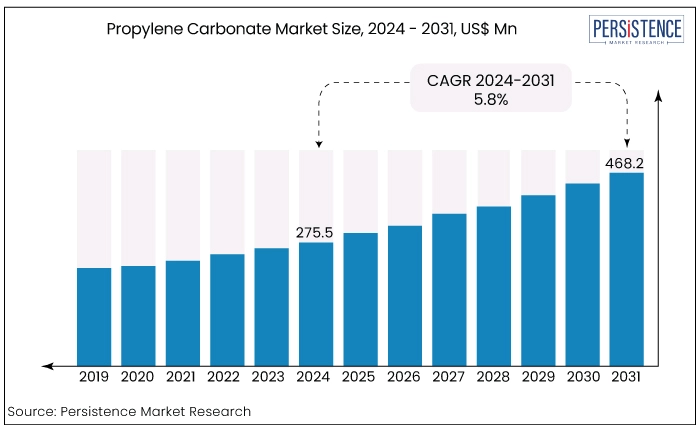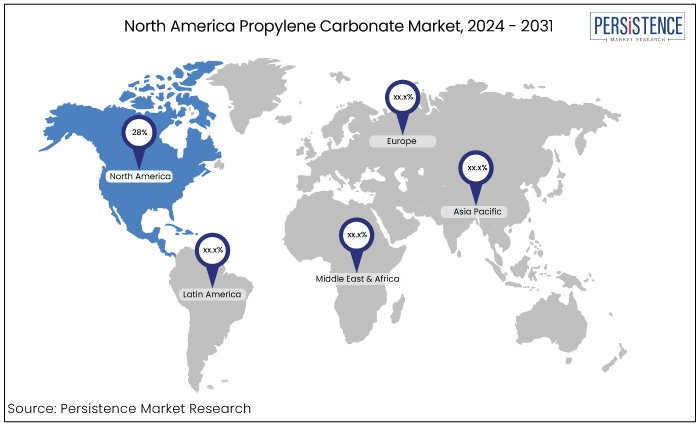Industry: Chemicals and Materials
Published Date: September-2024
Format: PPT*, PDF, EXCEL
Delivery Timelines: Contact Sales
Number of Pages: 160
Report ID: PMRREP34778
The propylene carbonate market is estimated to increase from US$275.5 Mn in 2024 to US$468.2 Mn by 2031. The market is projected to record a CAGR of 5.8% during the forecast period from 2024 to 2031. Expansion of the electronics industry along with the increased demand for lithium-ion batteries is one of the key parameter for the market’s growth. Paints & coatings industry finds major application which leads the market forward.

Key Highlights of the Market
|
Market Attributes |
Key Insights |
|
Market Size (2024E) |
US$275.5 Mn |
|
Projected Market Value (2031F) |
US$468.2 Mn |
|
Global Market Growth Rate (CAGR 2024 to 2031) |
5.8% |
|
Historical Market Growth Rate (CAGR 2019 to 2023) |
5.1% |
|
Region |
Market Value Share 2024 |
|
North America |
28% |
Propylene carbonate is anticipated to grow substantially in demand in North America during the forecast period. A strict environmental regulation and an increasing preference for such solutions drive the demand for sustainable chemical solutions.
Propylene carbonate is extensively utilized as a solvent and additive in several industries including cosmetics, medicines, and automotive fluids. Its low toxicity and ability to break down naturally make it compliant with regulatory standards, reassuring stakeholders about its safety and environmental friendliness.

The propylene carbonate market in the United States projected to expand at a CAGR of 5.7% over the projection period. Product demand is growing in several sectors due to their flexible applications and environmental advantages. It has extensive applications in automotive fluids, cosmetics, medicines, and as an industrial solvent.
The shift toward electric vehicles are a significant catalyst for the demand for this product as it plays a pivotal part in battery technology.
|
Category |
Market Share in 2024 |
|
Form - Aqueous |
84% |
Based on form, the propylene carbonate market is categorized into aqueous and pellets. Among these, the aqueous form to dominate the market. The aqueous form of propylene carbonate has established itself as the dominant accounting for 84% of the market share. The segment growth can be linked to its inherent benefits including safety and the flexibility to adopt different applications.
Aqueous carbonate, unlike other forms based on solvents has superior handling and safety qualities and is also water-soluble. Because of this, there is no use of organic solvents, which results in a decrease in the number of fires that occur within the industry.
Aqueous carbonate has a high degree of miscibility with a wide variety of polar substances, which opens it up to a wide variety of compatible applications and makes it an adaptable option for most businesses. When these advantages are considered together, the aqueous form emerges as the most desirable option in a significant market section.
|
Category |
Market Share in 2024 |
|
Application - Paints & Coatings |
30% |
Based on application, the propylene carbonate market is categorized into paints and coatings, pharmaceuticals and textile. Among these, the paints and coatings segment dominates the market. Paints and coatings sector accounted for the significant revenue share due to its growing use as a solvent in formulations and adhesive promoter in this industry.
The chemical is utilized excessively as a solvent in the formulation of paints and coatings, particularly in aqueous and high-performance coatings. It assists in boosting adhesion qualities, flexibility, and overall coating integrity particularly in demanding environments such as automotive and aerospace applications which acts as an adhesive promoter.
The utilization of propylene carbonate has played a significant role in the lithium-ion battery revolution serving as an essential solvent and electrolyte. The global market is experiencing a rapid increase in the use of electric vehicles and consumer gadgets. Therefore, it is anticipated that they will deplete these batteries, which are highly sought after.
The need for propylene carbonate is expected to rise establishing it as a crucial component in the shift toward clean energy. Methyl ethyl carbonate plays a supportive function in the innovative supply chains of the pharmaceutical and cosmetic sectors. Its solvency makes it a crucial primary substance for transporting active components in pharmaceutical delivery systems and cosmetic compositions.
The increasing demand for products in this industry is driving the potential growth in propylene carbonate sales as disposable incomes rise in old world. Unlike many standard solvents which include a large amount of volatile organic chemicals, this solvent is poisonous and has little biodegradability.
Given the increasing focus on environmental regulations and the overall industrial interest in sustainability matters, methyl ethyl carbonate offers a distinct advantage for businesses in their search for solutions. The criteria can potentially drive the use of methyl ethyl carbonate as a sustainable solvent.
The propylene carbonate market has witnessed a steady growth rate over the period from 2019 to 2023 driven by its wide application in industries such as electronics, automotive, and cosmetics. The growth was primarily fueled by increasing demand for propylene carbonate in lithium-ion batteries and as a solvent in various industrial processes.
The market is expected to continue its upward trajectory with a forecasted CAGR of 5.8% during the period from 2024 to 2031. Factors contributing to this growth include the rising adoption of electric vehicles, which boosts demand for lithium-ion batteries, and the expansion of the electronics sector.
The increasing use of propylene carbonate in personal care products and the development of eco-friendly solvents are anticipated to drive market expansion. However, fluctuations in raw material prices and environmental concerns related to its production could pose challenges to the market’s growth.
Increasing Demand for Lithium-Ion Batteries
One of the most significant growth drivers for the market is the escalating demand for lithium-ion batteries particularly in the electric vehicle (EV) sector. Propylene carbonate is a crucial component in the electrolyte solution used in these batteries due to its excellent solvation properties and high dielectric constant.
As governments and consumers increasingly focus on reducing carbon emissions, the adoption of EVs is accelerating globally. This surge in EV production directly correlates with a high demand for lithium-ion batteries, thereby boosting the propylene carbonate market.
Also, the growth of renewable energy storage systems, which rely on lithium-ion batteries, further amplifies the need for propylene carbonate.
Expansion of the Electronics Industry
The electronics industry particularly in Asia Pacific is witnessing rapid growth driving the demand for propylene carbonate. This compound is used as a solvent in the production of various electronic components including capacitors and transistors.
With the advent of advanced technologies like 5G, the Internet of Things (IoT), and artificial intelligence (AI), the production of electronic devices is expected to increase significantly. This expansion in electronics manufacturing not only amplifies the demand for propylene carbonate but also stimulates innovations in its applications.
As the industry continues to evolve, the need for high-purity solvents like propylene carbonate will remain crucial further propelling market growth.
Growing Use in Personal Care and Cosmetics
Propylene carbonate is increasingly being utilized in the personal care and cosmetics industry, where it serves as a solvent and viscosity regulator. Its ability to dissolve various ingredients while maintaining the stability of formulations makes it ideal for products such as lotions, creams, and hair care products.
The rising global demand for personal care products driven by increased consumer awareness and spending on grooming and skincare is contributing to the propylene carbonate market growth. The trend toward using safe and environment-friendly ingredients in cosmetics has led to a preference for propylene carbonate, which is considered less toxic and sustainable compared to some alternatives.
Fluctuations in Raw Material Prices
One of the primary restraints for the propylene carbonate market is the volatility in raw material prices particularly propylene oxide, which is a key precursor in its production. Prices of propylene oxide are subject to fluctuations due to factors such as changes in crude oil prices, supply chain disruptions, and variations in demand across different industries.
Price fluctuations can directly impact the production costs of propylene carbonate leading to uncertainty and reduced profit margins for manufacturers. The dependence on petrochemical derivatives for raw materials raises concerns about sustainability and long-term availability, potentially limiting market growth.
Environmental and Regulatory Challenges
The production and disposal of propylene carbonate pose environmental challenges that can restrain market growth. The manufacturing process involves the use of petrochemicals, contributing to greenhouse gas emissions and other environmental impacts.
As global environmental regulations become stringent, manufacturers of propylene carbonate may face increased pressure to adopt cleaner and more sustainable production methods, which could entail significant costs and technical challenges.
Regulatory scrutiny over the use of certain chemicals in consumer products, especially in the cosmetics and personal care sectors could limit the use of propylene carbonate or necessitate costly reformulations. These environmental and regulatory factors could slow market expansion especially in regions with strict environmental policies.
Expansion in Advanced Energy Storage Solutions
The growing focus on renewable energy and the need for efficient energy storage solutions present a significant opportunity for the propylene carbonate market. Beyond its established use in lithium-ion batteries, propylene carbonate has the potential to be used in next-generation battery technologies and other advanced energy storage systems.
As research into solid-state batteries and other innovative energy storage technologies progresses, the demand for high-performance solvents and electrolytes like propylene carbonate is expected to increase. This expansion into advanced energy storage caters to the burgeoning electric vehicle market and addresses the global need for reliable energy storage solutions particularly in the renewable energy sector.
Growth in the Pharmaceuticals and Cosmetics Sectors
Another transformative opportunity lies in the pharmaceuticals and cosmetics industries where propylene carbonate is increasingly valued for its versatility as a solvent and excipient. In pharmaceuticals, propylene carbonate is used to enhance the solubility and bioavailability of active pharmaceutical ingredients. Consequently, making it a key component in the formulation of injectable drugs and topical applications.
The growing demand for innovative drug delivery systems coupled with the expansion of the global pharmaceutical industry presents a lucrative opportunity for the propylene carbonate market. Similarly, in the cosmetics sector, the trend toward natural and safe ingredients is driving the adoption of propylene carbonate as a solvent in various skincare and haircare products.
The propylene carbonate market is characterized by the presence of several key players, including BASF SE, Huntsman Corporation, Empower Materials, and LyondellBasell Industries, among others. These companies compete based on product quality, price, and innovation.
The market is moderately fragmented with players focusing on expanding their production capacities, investing in research and development, and forming strategic partnerships to enhance their market share.
The increasing demand for eco-friendly solvents and the rising adoption of propylene carbonate in emerging industries such as advanced batteries and personal care products are driving competition. Regional players in Asia Pacific particularly in China are gaining prominence due to their cost-effective production methods and expanding local demand.
Recent Industry Developments in the Propylene Carbonate Market
|
Attributes |
Details |
|
Forecast Period |
2024 to 2031 |
|
Historical Data Available for |
2019 to 2023 |
|
Market Analysis |
US$ Million for Value |
|
Key Regions Covered |
|
|
Key Market Segments Covered |
|
|
Key Companies Profiled in the Report |
|
|
Report Coverage |
|
|
Customization & Pricing |
Available upon request |
By Form
By Application
By Region
To know more about delivery timeline for this report Contact Sales

The market is estimated to value at US$468.2 Mn by 2031.
The market is projected to exhibit a CAGR of 5.8% over the forecast period.
A few of the leading industry participants in the market are LyondellBasell Industries, Shandong Depu Chemical, and BASF SE.
Expansion of the electronics industry drives the market forward.
Expansion in advanced energy storage solutions presents a key opportunity for the market players.